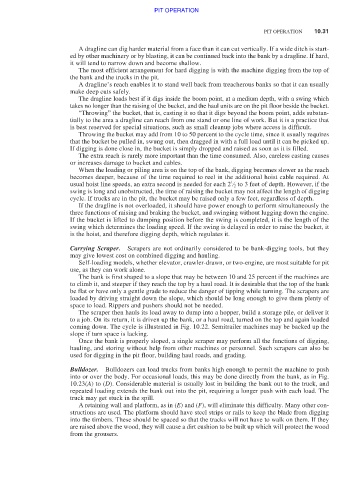Page 525 - Moving the Earth_ The Workbook of Excavation
P. 525
PIT OPERATION
PIT OPERATION 10.31
A dragline can dig harder material from a face than it can cut vertically. If a wide ditch is start-
ed by other machinery or by blasting, it can be continued back into the bank by a dragline. If hard,
it will tend to narrow down and become shallow.
The most efficient arrangement for hard digging is with the machine digging from the top of
the bank and the trucks in the pit.
A dragline’s reach enables it to stand well back from treacherous banks so that it can usually
make deep cuts safely.
The dragline loads best if it digs inside the boom point, at a medium depth, with a swing which
takes no longer than the raising of the bucket, and the haul units are on the pit floor beside the bucket.
“Throwing” the bucket, that is, casting it so that it digs beyond the boom point, adds substan-
tially to the area a dragline can reach from one stand or one line of work. But it is a practice that
is best reserved for special situations, such as small cleanup jobs where access is difficult.
Throwing the bucket may add from 10 to 50 percent to the cycle time, since it usually requires
that the bucket be pulled in, swung out, then dragged in with a full load until it can be picked up.
If digging is done close in, the bucket is simply dropped and raised as soon as it is filled.
The extra reach is rarely more important than the time consumed. Also, careless casting causes
or increases damage to bucket and cables.
When the loading or piling area is on the top of the bank, digging becomes slower as the reach
becomes deeper, because of the time required to reel in the additional hoist cable required. At
1
usual hoist line speeds, an extra second is needed for each 2 ⁄ 2 to 3 feet of depth. However, if the
swing is long and unobstructed, the time of raising the bucket may not affect the length of digging
cycle. If trucks are in the pit, the bucket may be raised only a few feet, regardless of depth.
If the dragline is not overloaded, it should have power enough to perform simultaneously the
three functions of raising and braking the bucket, and swinging without lugging down the engine.
If the bucket is lifted to dumping position before the swing is completed, it is the length of the
swing which determines the loading speed. If the swing is delayed in order to raise the bucket, it
is the hoist, and therefore digging depth, which regulates it.
Carrying Scraper. Scrapers are not ordinarily considered to be bank-digging tools, but they
may give lowest cost on combined digging and hauling.
Self-loading models, whether elevator, crawler-drawn, or two-engine, are most suitable for pit
use, as they can work alone.
The bank is first shaped to a slope that may be between 10 and 25 percent if the machines are
to climb it, and steeper if they reach the top by a haul road. It is desirable that the top of the bank
be flat or have only a gentle grade to reduce the danger of tipping while turning. The scrapers are
loaded by driving straight down the slope, which should be long enough to give them plenty of
space to load. Rippers and pushers should not be needed.
The scraper then hauls its load away to dump into a hopper, build a storage pile, or deliver it
to a job. On its return, it is driven up the bank, or a haul road, turned on the top and again loaded
coming down. The cycle is illustrated in Fig. 10.22. Semitrailer machines may be backed up the
slope if turn space is lacking.
Once the bank is properly sloped, a single scraper may perform all the functions of digging,
hauling, and storing without help from other machines or personnel. Such scrapers can also be
used for digging in the pit floor, building haul roads, and grading.
Bulldozer. Bulldozers can load trucks from banks high enough to permit the machine to push
into or over the body. For occasional loads, this may be done directly from the bank, as in Fig.
10.23(A) to (D). Considerable material is usually lost in building the bank out to the truck, and
repeated loading extends the bank out into the pit, requiring a longer push with each load. The
truck may get stuck in the spill.
A retaining wall and platform, as in (E) and (F), will eliminate this difficulty. Many other con-
structions are used. The platform should have steel strips or rails to keep the blade from digging
into the timbers. These should be spaced so that the tracks will not have to walk on them. If they
are raised above the wood, they will cause a dirt cushion to be built up which will protect the wood
from the grousers.

